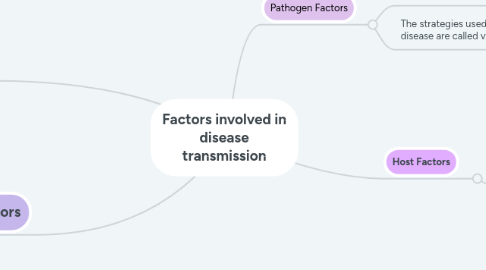Factors involved in disease transmission
by Margy Bartlett-Vowles


1. Environmental and Geographical Factors
1.1. Natural disasters can increase the chance of an outbreak of disease due to poor sanitation and the spread of contaminated water which has been spread through floods and hurricanes.
2. Societal Factors
2.1. Overcrowded areas are more susceptible to host to host transmission.
2.2. Those who don't vaccinate their kids are also at risk for preventable infectious diseases
2.3. Those not exposed to many diseases, such as the Indigenous Australians are more susceptible than those who have exposed to it.
3. Pathogen Factors
3.1. Some pathogens hold natural reservoirs In food, water and the environment
3.1.1. Examples include leptospirosis and cholera
3.2. The strategies used by pathogens to cause disease are called virulence factors
4. Host Factors
4.1. Hosts have a variety of reasons why they are more vulnerable compared to other hosts
4.1.1. This is because they may be more susceptible to diseases, since they may be fighting other diseases such as HIV/AIDS or are suffering from malnutrition

